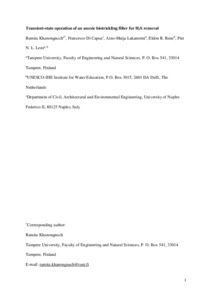Transient–state operation of an anoxic biotrickling filter for H2S removal
Khanongnuch, Ramita; Di Capua, Francesco; Lakaniemi, Aino-Maija; Rene, Eldon R.; Lens, Piet (2019-09-05)
Khanongnuch, Ramita
Di Capua, Francesco
Lakaniemi, Aino-Maija
Rene, Eldon R.
Lens, Piet
05.09.2019
Julkaisun pysyvä osoite on
https://urn.fi/URN:NBN:fi:tty-201906171892
https://urn.fi/URN:NBN:fi:tty-201906171892
Kuvaus
Peer reviewed
Tiivistelmä
The application of an anoxic biotrickling filter (BTF) for H2S removal from contaminated gas streams is a promising technology for simultaneous H2S and NO3− removal. Three transient–state conditions, i.e. different liquid flow rates, wet–dry bed operations and H2S shock loads, were applied to a laboratory–scale anoxic BTF. In addition, bioaugmentation of the BTF with a H2S removing–strain, Paracoccus MAL 1HM19, to enhance the biomass stability was investigated. Liquid flow rates (120, 60 and 30 L d−1) affected the pH and NO3− removal efficiency (RE) in the liquid phase. Wet–dry bed operations at 2–2 h and 24–24 h reduced the H2S elimination capacity (EC) by 60–80%, while the operations at 1–1 h and 12–12 h had a lower effect on the BTF performance. When the BTF was subjected to H2S shock loads by instantly increasing the gas flow rate (from 60 to 200 L h−1) and H2S inlet concentration (from 112 (± 15) to 947 (± 151) ppmv), the BTF still showed a good H2S RE (>93%, EC of 37.8 g S m–3 h–1). Bioaugmentation with Paracoccus MAL 1HM19 enhanced the oxidation of the accumulated S0 to sulfate in the anoxic BTF.
Kokoelmat
- TUNICRIS-julkaisut [16929]
